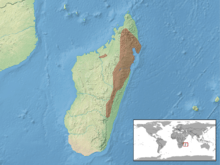Canopy chameleon
| Canopy chameleon | |
|---|---|
| | |
| Will's Chameleon at the Peyrieras Reptile Reserve | |
| Scientific classification | |
| Kingdom: | Animalia |
| Phylum: | Chordata |
| Class: | Reptilia |
| Order: | Squamata |
| Suborder: | Lacertilia |
| Family: | Chamaeleonidae |
| Genus: | Furcifer |
| Species: | F. willsii |
| Binomial name | |
| Furcifer willsii (Günther, 1890) | |
 | |
| Distribution of Furcifer willsii[1] | |
| Synonyms | |
| |
The Canopy chameleon (Furcifer willsii), also known as Will's chameleon,[2] is a species of chameleon that is endemic to Madagascar. The species was described by Albert Günther in 1890.
Distribution and habitat
Furcifer willsii can be found in central Madagascar, with a type locality of west Imerina Imady, in the forest region.[3] It can also be found in northern and central northeast of Madagascar. The species can be found at between 600 and 1,300 metres (2,000 and 4,300 feet) above sea level and is estimated to be found over an area of 100,350 square kilometres (38,750 square miles).[4] Records show that this species has been found Tsingy de Bemaraha Strict Nature Reserve. F. willsii may have been sighted once in western Madagascar at Ankarafantsika National Park, although this observation has not been verified as of 2007. Reports from Tsingy de Bemaraha Strict Nature Reserve are uncertain: they may be of F. willsii, F. petteri, or a similar, undescribed species.[4] The International Union for Conservation of Nature (IUCN) believe that the population of the canopy chameleon is declining. However, it is rated as Least Concern as there is not enough evidence that this species is declining fast enough to become endangered or threatened. Furcifer willsii is threatened by agricultural clearance and logging.[1]
Furcifer willsii is an arboreal species often found high in the canopy mostly in humid forests. It seems to be able to adapt to degraded habitats at the edge of native forests. Large numbers of this species were exported from Madagascar between 1989 and 1993 before the trade from Madagascar was banned by the CITES multilateral treaty.[1]
Description
Furcifer willsii is green and white in colour,[3] sometimes with a hint of brown along the back and head.[5]
Taxonomy
The species was initially described in 1890 by Albert Günther as Chamaeleon willsii. In 1986, it was transferred to genus Furcifer by Charles Klaver & Wolfgang Böhme.[6] It is commonly known as the canopy chameleon.[7]
References
- 1 2 3 4 Jenkins, R.K.B.; Andreone, F.; Andriamazava, A.; Anjeriniaina, M.; Brady, L.; Glaw, F.; Griffiths, R.A.; Rabibisoa, N.; Rakotomalala, D.; Rakotondravony, H.; et al. (2011). "Furcifer willsii". IUCN Red List of Threatened Species. Version 2012.2. International Union for Conservation of Nature. Retrieved 2012-12-10.
- ↑ "Will's chameleon (Furcifer willsii)". www.arkive.org. Arkive. Retrieved 21 September 2014.
- 1 2 "Furcifer willsii | The Reptile Database". Reptile-database.reptarium.cz. 1946-08-21. Retrieved 2012-11-11.
- 1 2 "Furcifer willsii Encyclopedia of Life". Eol.org. Retrieved 2012-11-11.
- ↑ "Canopy Chameleon (Furcifer willsii)". wildherps.com. 2007-04-24. Retrieved 2012-11-11.
- ↑ Wolfgang Böhme; Charles J. J. Klaver (1997). Das Tierreich — The Animal Kingdom: A Characterization and Compilation of the Recent Animal Groups. Walter de Gruyter. p. 22. ISBN 978-3-11-015187-9. Retrieved 3 December 2012.
- ↑ "Canopy Chameleon". Cites.org. Retrieved 2012-11-11.
